 | |
| Author | David "Zeb" Cook |
|---|---|
| Genre | Role-playing game |
| Publisher | TSR |
Publication date | 1989 |
| Media type | Boxed set |
Time of the Dragon is an accessory for the Dragonlance campaign setting of the Advanced Dungeons & Dragons fantasy role-playing game.
 | |
| Author | David "Zeb" Cook |
|---|---|
| Genre | Role-playing game |
| Publisher | TSR |
Publication date | 1989 |
| Media type | Boxed set |
Time of the Dragon is an accessory for the Dragonlance campaign setting of the Advanced Dungeons & Dragons fantasy role-playing game.
Time of the Dragon is an accessory for the Dragonlance campaign setting which details the continent of Taladas of the setting's world of Krynn. [1] Taladas has its own unique cultures and geography, and as it plays no major role in the War of the Lance, Taladas remained relatively untouched by its events. [2] The peoples who inhabit this continent have different views and lifestyles from those of Ansalon, including their relationship with the gods. The dragons of Taladas are also different in their outlook, and are more neutral in outlook due to the role Takhisis, the Queen of Darkness played with Taladas during the War of the Lance. The need to survive has colored the outlooks of the other races of Taladas, making the cultures of Taladas darker in mood than those of Ansalon. [2]
The 112-page "The Guide Book to Taladas" details both the physical geography and politics of Taladas, which includes the societies of the minotaurs and gnomes. [1] After a brief history of the continent, the book discusses Taladas's geography one area at a time, and its impact on its peoples and how they had adapted. During the Cataclysm, one particularly huge meteorite struck the continent, causing volcanoes to erupt, and earthquakes shattered the land; volcanic dust fell over the continent, the seas were poisoned, and land masses shifted, leaving a vast sea of molten lava in the center of Taladas, surrounded by volcanoes. [2] In the northwest part of Taladas are the steppe-dwelling Uigan, who draw their inspiration from the Mongols and Huns of historic Earth. [2] The elves of this area are similar to the Uigan, being nomadic horse warriors. The goblins follow a settled lifestyle, living in small villages and hunting for food, ambushing elven and human horsemen, and making war with the elves. The Marak kender are different from the cute, cheerful ones of Ansalon, changed into a race marked by suspicion and paranoia. The Fianawar dwarves, having been driven from their underground homes by the Cataclysm, have developed a fear of the underground. The League of Minotaurs is the largest power in Taladas, and its society has built in controls to regulate the belief that might makes right. The minoi gnomes love to build devices but lack the logical minds necessary to make them work effectively, while the gnomoi gnomes are far more practical and control gnomish society, taking steps to make sure that it stays stable and develops. [2]
The 48-page "The Rule Book of Taladas" presents rules on how to use character races found in the setting, and statistics for new monsters. [1] This booklet contains game rules specific to Taladas, and makes new player character races available, including the bakali (a race of lizardmen), goblins, minotaurs, and ogres. [2] The book also discusses changes required to make standard character classes fit smoothly into Taladas, and provides player-character kits that summarize the various abilities, skills, proficiencies and backgrounds for 34 common character classes and races. [2] Army organization charts and statistics are included for the Battlesystem supplement. [2] Also included is a selection of monsters that inhabit Taladas. [2]
Two large color maps in the set detail Taladas, while a third map shows the area of the League of the Minotaurs, and a fourth map details the major city of Kristophan. [1] Also included are twenty-four map cards, each having a color illustration on one side and a description of an area on the other side for important locations and diagrams of equipment for characters. [1] The color cards show clothing and armor styles, gnomish devices and a gnome citadel, and areas of the city of Kristophan in more detail. [2]
Time of the Dragon was written by David "Zeb" Cook, with a cover by Robin Wood and interior illustrations by Stephen Fabian, Fred Fields, and Ned Dameron, and was published by TSR in 1989 as a boxed set containing a 112-page book, a 48-page book, four large color maps, and 24 cardstock sheets. [1] Editing was by Mike Breault and Jon Pickens, with cartography by Dave Sutherland and David "Diesel" LaForce. [2]
In the February–March 1990 edition of Games International (Issue 13), Dave Hughes called the background information of Taladas "staggeringly comprehensive," writing that the history presented was "not only interesting and believable, it is also exciting and different enough for you to be thinking of adventure ideas as you read [it]." He did have issues with the nine new monsters, calling them "mostly derivative", and spell lists and rules to be incompatible with recent TSR releases. He concluded by giving this a below-average rating of 6 out of 10, saying, "If you have been looking for a new direction in which to take your players, look at this." [3]
Jim Bambra reviewed Time of the Dragon for Dragon magazine #161 (September 1990). [2] Bambra concluded by saying that "The background of Time of the Dragon is plausible and meticulously presented, with neatly integrated cultures and races. It can easily be used as a campaign setting in its own right, as it not tightly tied to the world of Krynn. Time of the Dragon is well worth looking at and marks a departure from the standard Dragonlance saga setting. It has plenty to recommend it to gamers looking for a harsh and gritty fantasy world." [2]
Lawrence Schick, in his 1991 book Heroic Worlds called the set "A nice package", and commented on the setting: "Taladas's strange and exotic cultures (for example, a society of civilized minotaurs) exhibit an unusual mix (for AD&D) of magic and science." [1]
Dragonlance is a shared universe created by Laura and Tracy Hickman, and expanded by Tracy Hickman and Margaret Weis under the direction of TSR, Inc. into a series of fantasy novels. The Hickmans conceived Dragonlance while driving in their car on the way to TSR for a job interview. Tracy Hickman met his future writing partner Margaret Weis at TSR, and they gathered a group of associates to play the Dungeons & Dragons role-playing game. The adventures during that game inspired a series of gaming modules, a series of novels, licensed products such as board games, and lead miniature figures.
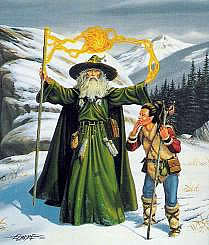
Kender are a type of fantasy race first developed for the Dragonlance campaign setting for the Dungeons & Dragons fantasy role playing game published by TSR, Inc. in 1984. The first kender character was created by Harold Johnson as a player character in a series of role-playing adventures co-authored by Tracy Hickman and Margaret Weis. Weis and Hickman's Dragonlance shared world novels introduced the kender to readers and players alike, largely through the character Tasslehoff Burrfoot, who became one of the main protagonists in the series.

Dragonlance Adventures is a 128-page hardcover book for the Dragonlance campaign setting for the first edition of the Advanced Dungeons & Dragons fantasy role-playing game.
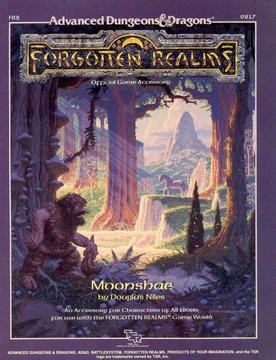
Moonshae is an accessory for the Dungeons & DragonsForgotten Realms campaign setting. It describes the Moonshae Isles of Faerûn.

The elf is a humanoid race in the Dungeons & Dragons fantasy role-playing game, one of the primary races available for player characters, and play a central role in the narratives of many setting worlds of the game. Elves are described as renowned for their grace and mastery of magic and weapons such as the bow and sword. Becoming physically mature by the age of 25 and emotionally mature at around 125, they are also famously long-lived, capable of living more than half a millennium and remaining physically youthful. Possessed of innate beauty and easy gracefulness, they are viewed as both wondrous and haughty by other races in-universe; however, their natural detachment is seen by some as introversion or xenophobia. They were usually portrayed as antagonistic towards dwarves.

In the Dungeons & Dragons fantasy role-playing game, the centaur is a large monstrous humanoid. Based upon the centaurs of Greek myth, a centaur in the game resembles a human with the lower body of a horse.
The DL series is a series of adventures and some supplementary material for the Advanced Dungeons & Dragons role playing game. These modules along with the Dragonlance Chronicles trilogy of novels, which follow one possible adventure series through the modules, were the first published items that established the Dragonlance fictional universe. The original DL series was released from 1984 to 1986, with the final two modules added to it in 1988. In the 1990s these roleplaying adventures from the original series were collected and revised for 2nd Edition AD&D as the three DLC Dragonlance Classics modules. There were also versions of the module series released in 1999, 2000 and 2006.
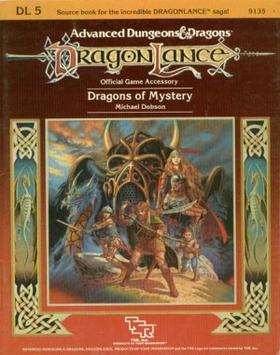
Dragons of Mystery is a Dungeons & Dragons sourcebook published in 1984 as part of a series of modules for the Dragonlance (DL) campaign setting. It is the fifth of fourteen Dragonlance modules published by TSR between 1984 and 1986. Its cover features a painting by Larry Elmore of the characters Tanis Half-Elven, Laurana Kanan, Tasslehoff Burrfoot, and Tika Waylan standing in front of a dragon highlord and a blue dragon. The sourcebook received middling reviews from White Dwarf magazine.
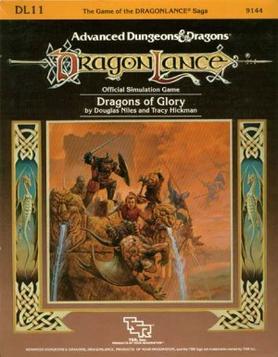
Dragons of Glory is a Dungeons & Dragons source book in a series of modules from the Dragonlance campaign setting. It is one of the 16 DL modules published by TSR between 1984 and 1986.
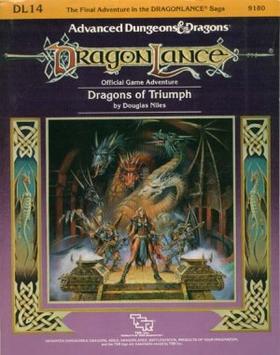
Dragons of Triumph is the fourth and final module in the third story arc of the 14-module Dragonlance (DL) series of the Dungeons & Dragons adventure role-playing game. The series was published by TSR between 1984 and 1986. The game's cover art work by Clyde Caldwell features Laurana Kanan chained on a platform before the goddess of evil, Takhisis.
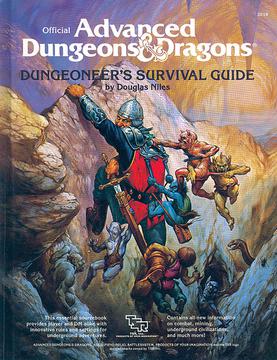
Dungeoneer's Survival Guide is a supplement to the Dungeons & Dragons fantasy role-playing game. The book was written by Douglas Niles, and published by TSR, Inc. in 1986.

Ravenloft: Realm of Terror is a boxed set accessory published in 1990 for the Ravenloft campaign setting for the Advanced Dungeons & Dragons fantasy role-playing game.
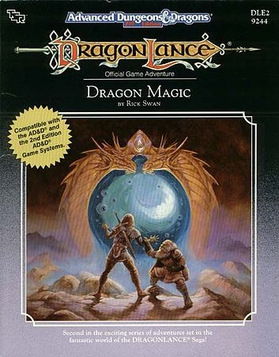
Dragon Magic is an adventure module published by TSR in 1989 for the Dungeons & Dragons fantasy role-playing game, specifically the Dragonlance campaign setting.

The Trail Map series consists of several accessories for the Dungeons & Dragons fantasy role-playing game.

Player's Guide to the Dragonlance Campaign is an accessory for the 2nd edition of the Advanced Dungeons & Dragons fantasy role-playing game, published in 1993.

Dragonlance: Fifth Age is an accessory for the SAGA System, published in 1996. It uses the setting of Dragonlance, which originally was used in the Advanced Dungeons & Dragons fantasy role-playing game.

Tales of the Lance is a boxed set issued by TSR for Dragonlance. It includes maps, source books, and player stat cards for various non-player characters (NPCs).

Ents of Fangorn is a supplement published by Iron Crown Enterprises in 1987 for Middle-earth Role Playing (MERP), a fantasy role-playing game based on J.R.R. Tolkien's The Lord of the Rings.
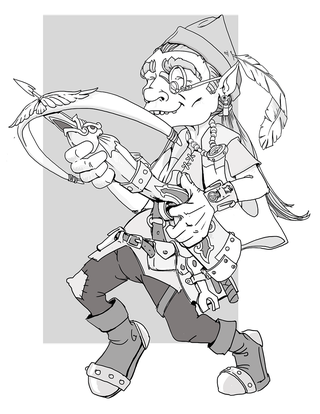
In the Dungeons & Dragons fantasy role-playing game, gnomes are one of the core races available for play as player characters. Some speculate that they are closely related to dwarves; however, gnomes are smaller and more tolerant of other races, nature, and magic. Depending on the setting and subrace, they are often skilled with illusion magic or engineering. Gnomes are small humanoids, standing 3–3.5 feet (91–107 cm) tall.